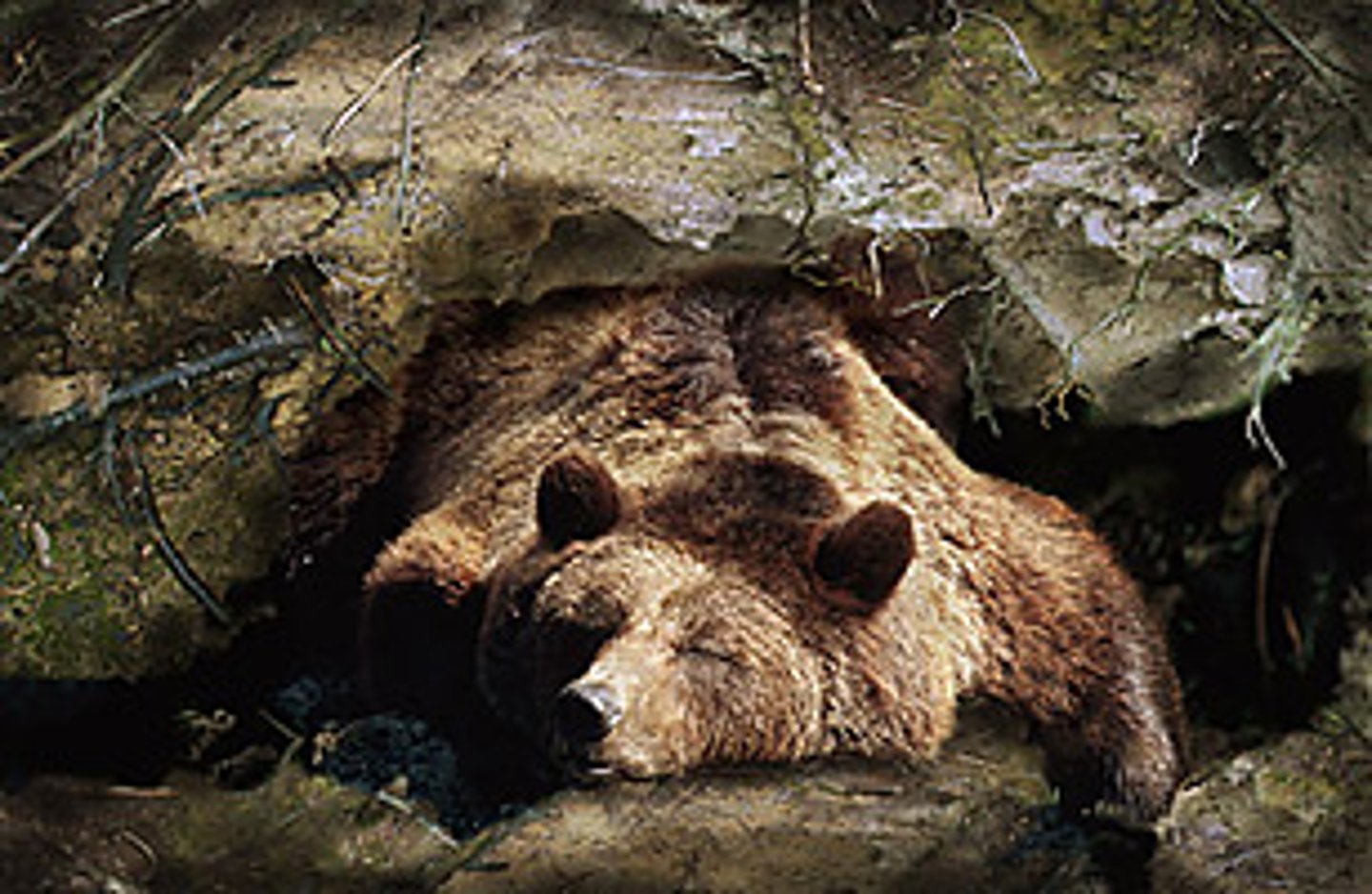Chap 7 Animal adaptations
1/104
There's no tags or description
Looks like no tags are added yet.
Name | Mastery | Learn | Test | Matching | Spaced |
|---|
No study sessions yet.
105 Terms
Smallest animals weigh about
2-10 micrograms
largest living animals
aquatic
- blue whale (100,000 kg)
--------------------
terrestrial
- African elephant (5000kg
allometric scaling
surface areas (SA) and volumes (V) of animals are related to their linear dimensions
- most morphological and physio. features change as a function of body size in a predictable way
How are surface area and volume related?
square
- SA = L x L = L^2
- square does not have volume
--------------------
cube
- SA = 6 x L^2
- V = I^3
--------------------
volume increases at a faster rate than surface area size of the cube increases
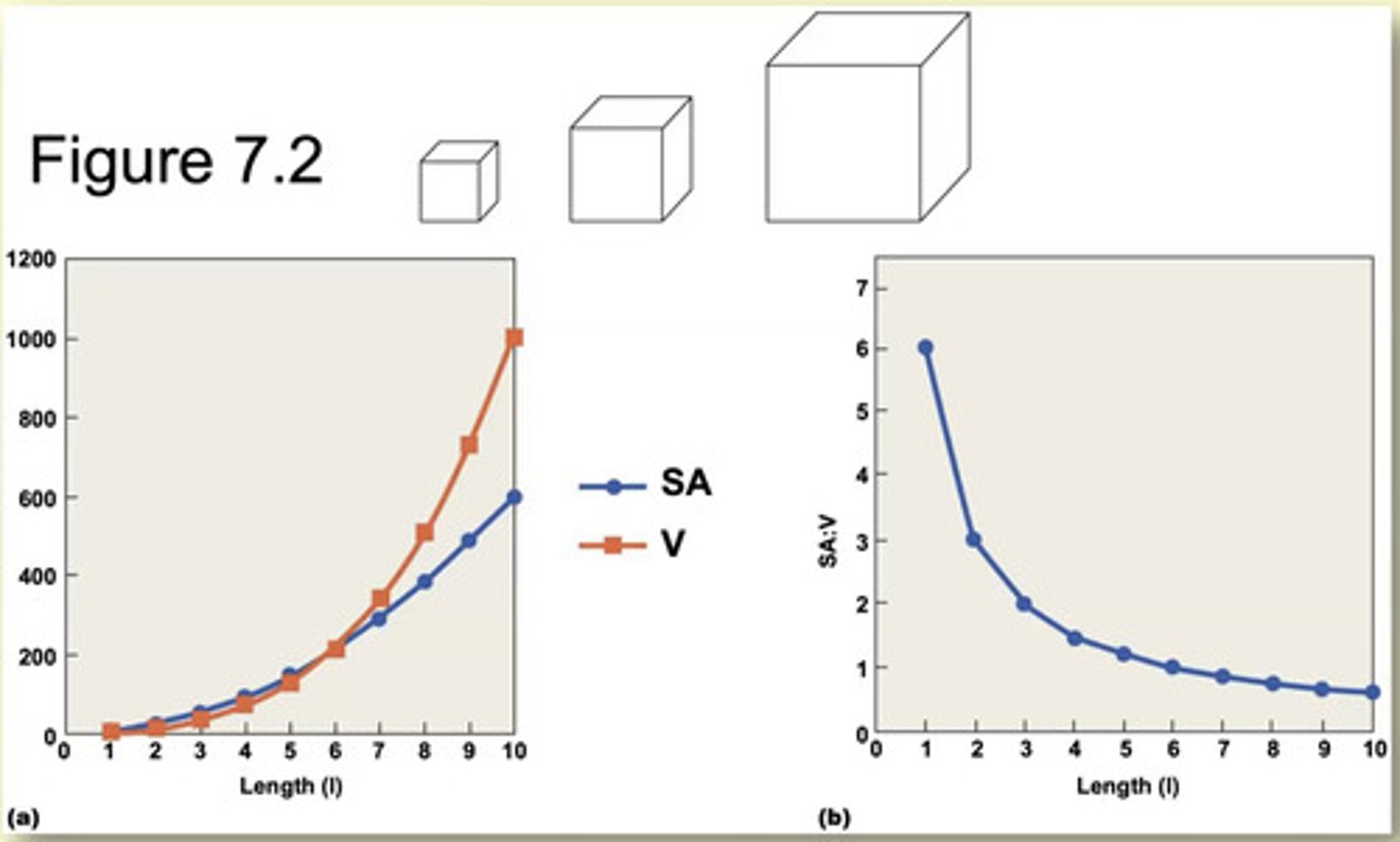
Why does this relationship between SA and V impose a critical constraint on the evolution of animals?
- many basic physio. and biochemical processes require the transfer of materials and energy between the exterior (environment) and interior of the organism
gas exchange
animals require a supply of O2 for cellular respiration and release Co2 as a waste product
- oxygen readily diffuses into cells and can diffuse into a millimeter of tissue in seconds
- if an organism is thin, O2 can diffuse into the cell
What about an golf sized organism (21mm) how long would it take oxygen to diffuse into the center
more than an hour
- cells near the surface would receive enough O2 but those deeper in the vole would not
active transport of O2 into the interior of the body
- tubular body with a central chamber
- water drawn into the inner chamber allows oxygen to diffuse to interior cells
- organs and organ systems bring O2 into the body and is transported through out the body
vertebrates (oxygen transport)
lungs/gills (circulatory system)
- hemoglobin transports O2 picked up at lungs/gill through blood vessels
Digestion
- acquiring energy
- acquiring nutrients
- release of waste products
Digestive system
tube in which digestion occurs
--------------------
RESPONSIBLE FOR
- breakdown of food
- absorption/distribution of nutrients (throughout the body)
- exit of waste products
Waste products exit
some animals
- single opening
--------------------
most animals
- two opening (US)
- mouth = food enters
- anus = waste exits
digestive tracts
can vary greatly among animals
- the > the surface area = the > the absorption of food
- influenced by the type of food eaten (diet)
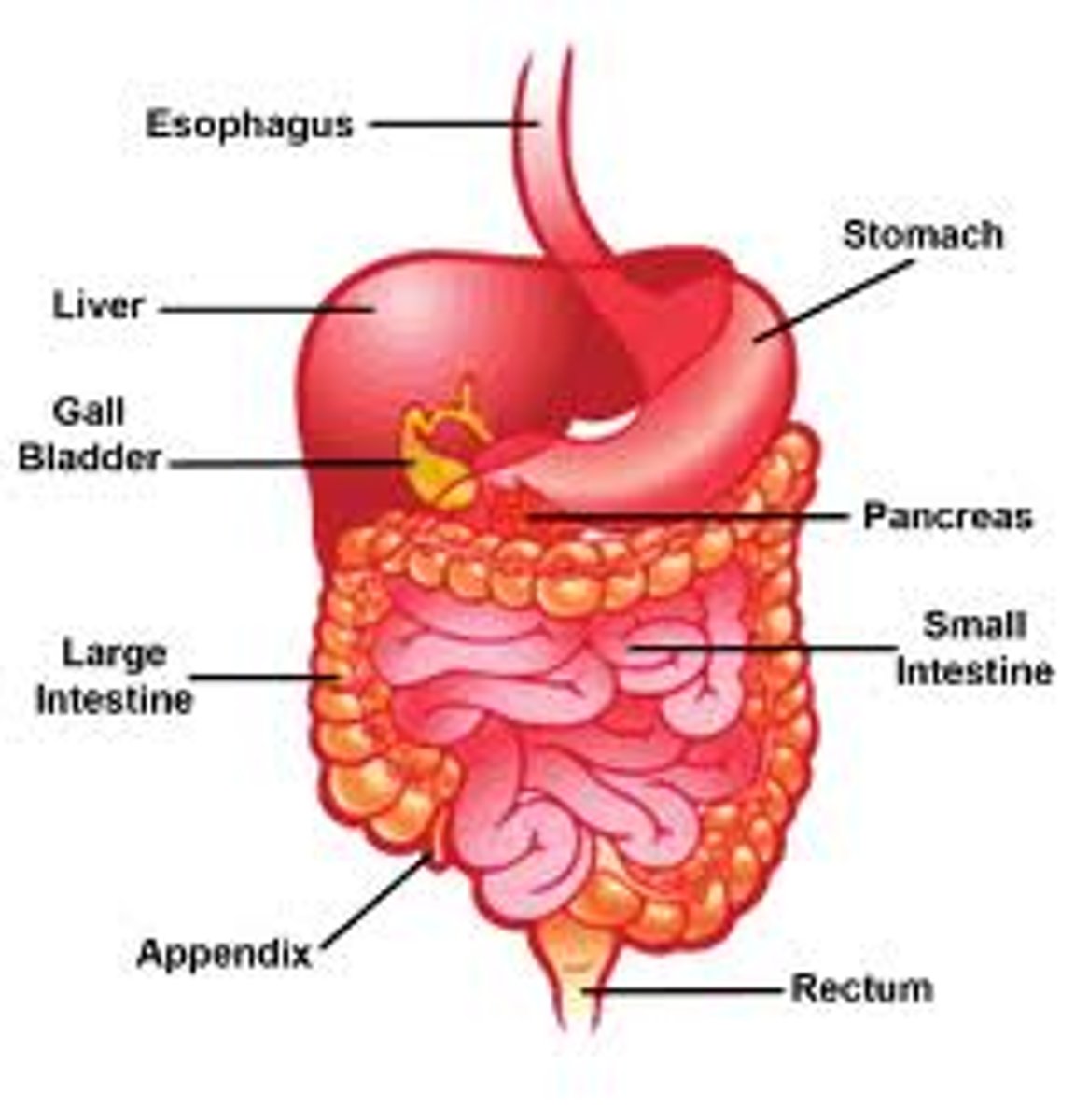
Herbivors
only feeds on plants tissues
What challenges faced by animals that feed only on plant tissue
- plants are low in protein
- plants are high in carbohydrate
(lignin and cellulose are difficult to break down)
Herbivores Categories
- Grazers
- Browsers
- Granivores
- frugivores
grazers
leaves and grass
--------------------
- diets are high in cellulose
- long chains of glucose molecules
- rich in carbon, low in protein
- most animals do not produce enzymes that can digest cellulose
mutualistic bacteria and protists (grazers)
symbionts that live in a grazers digestive tract
--------------------
FUNCTIONS
- digest cellulose and proteins
- synthesize fatty acids, amino acids, proteins , and vitamins
browsers
woody material
granivores
seed eaters
frugivores
fruit eaters
specialized herbivores
Plant Sap
- birds insects (aphids)
--------------------
Nectivores
- hummingbirds, butterflies, bees
carnivores
eat other animals
--------------------
FEATURES
- don't have problems with food quality or digesting cellulose
- don't have problems digesting and assimilating nutrients from prey (due to chemical comp. of the tissue is similar)
quantity of food consumed..
is important
- food is limited
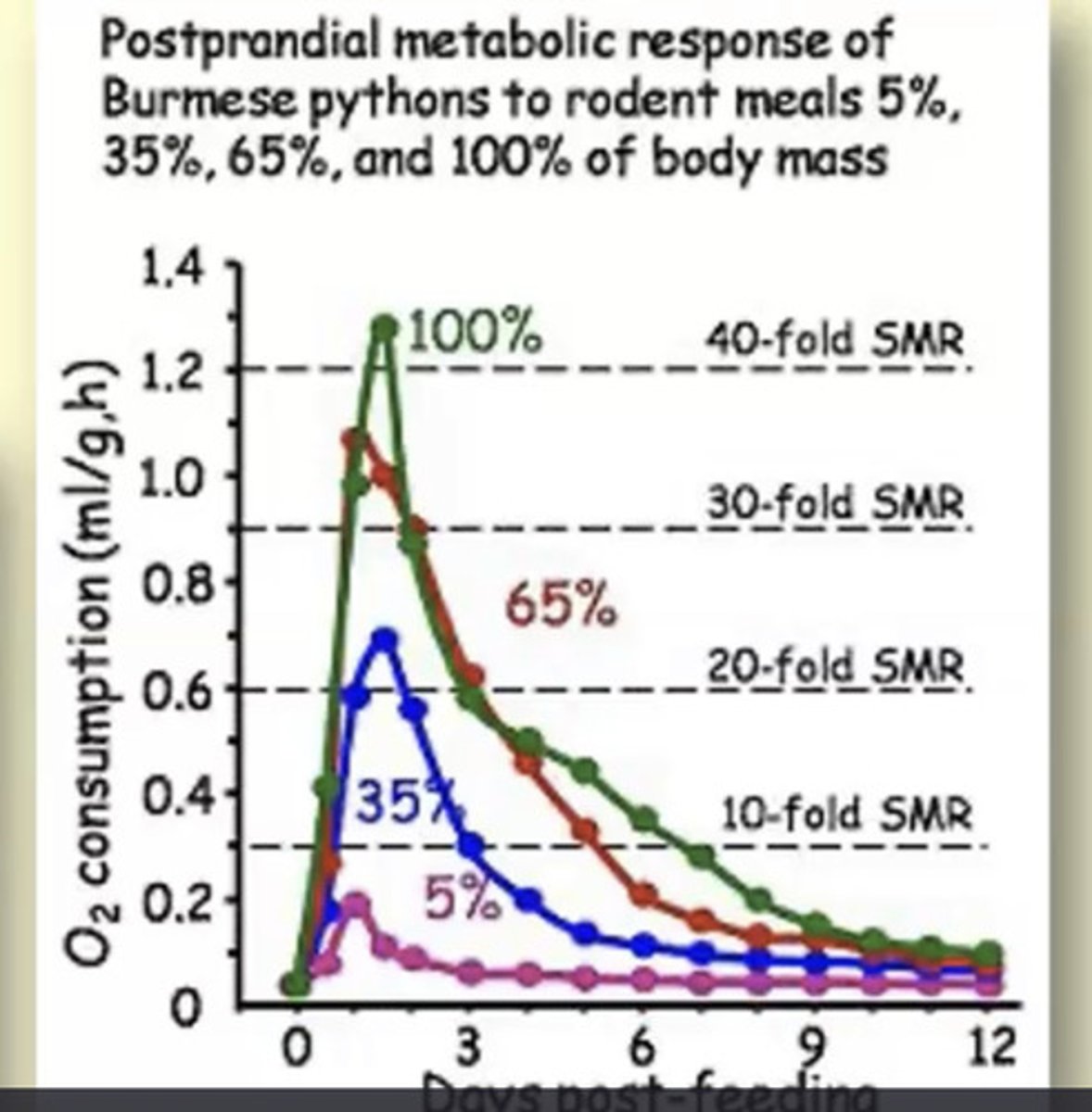
where does the energy go during digestion? (carnivores)
- upregulation in enzyme levels
- increased microvilli length
- heart grows in size
- neural growth
-ETC
Omnivores
eat both plants and animals
--------------------
FEATURES:
- diet may vary with the seasons, stages in the life cycle, size, and growth rate
--------------------
EX:
- red fox = eat berries and grasses, insects/small rodents
- black bears= vegetation ,nuts, tree bark, insects , fish , medium-sized mammals
- frogs = algae and insects
Environmental variation
occurs across a wide range of timescales
- some changes are regular
- some are less predictable
--------------------
CAN RESPOND IN 2 DIFFERENT WAYS
- Conform
- regulate
conform
Adjusting one's behavior or thinking to coincide with a group standard.
regulate
to manage or control
- "maintain set point"
conformers
change in external environment cause parallel changes in the body
--------------------
- unable to maintain consistent internal conditions that are different than the external environment
- solute and O2 concentration,
--------------------
EX: starfish (echinoderm) living in marine environments is a conformer
A conformer's ability to survive environmental changes depends on
its range of tolerance to internal changes
regulators
changes in the external environment do not cause internal changes
- able to maintain consistent internal conditions that are different than the external environment over a broad range of environmental conditions
How is regulation achieved? what are some proximate mechanisms of regulation?
biochemical, physiological, morphological, behavioral mechanisms
what are some cost and benefits for both conformer and regulator
Conformer
- benefit = low energetic expenditure, mechanisms to maintain a consistent internal environment not needed
- costs = if environmental conditions are not optimal, it can lead to reduced activity, growth, reproduction
--------------------
regulation
- benefit = greatly extended range of environmental conditions for activity, growth, reproduction, and increased level of performance
- cost = usually energetically expensive (due to ion pumps to osmoregulate)
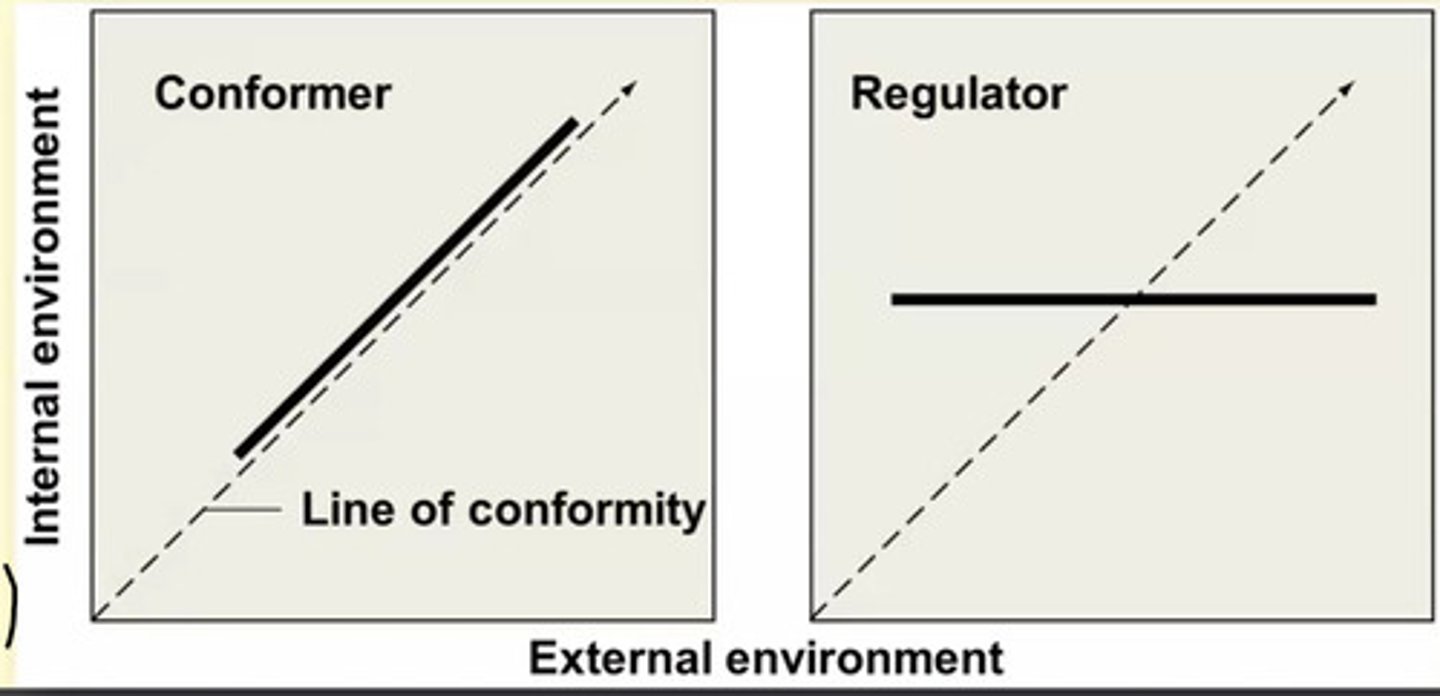
species can regulate with respect to one feature but conform to another
regulation may vary due to life history stage
- thermoregulation during reproduction in pythons
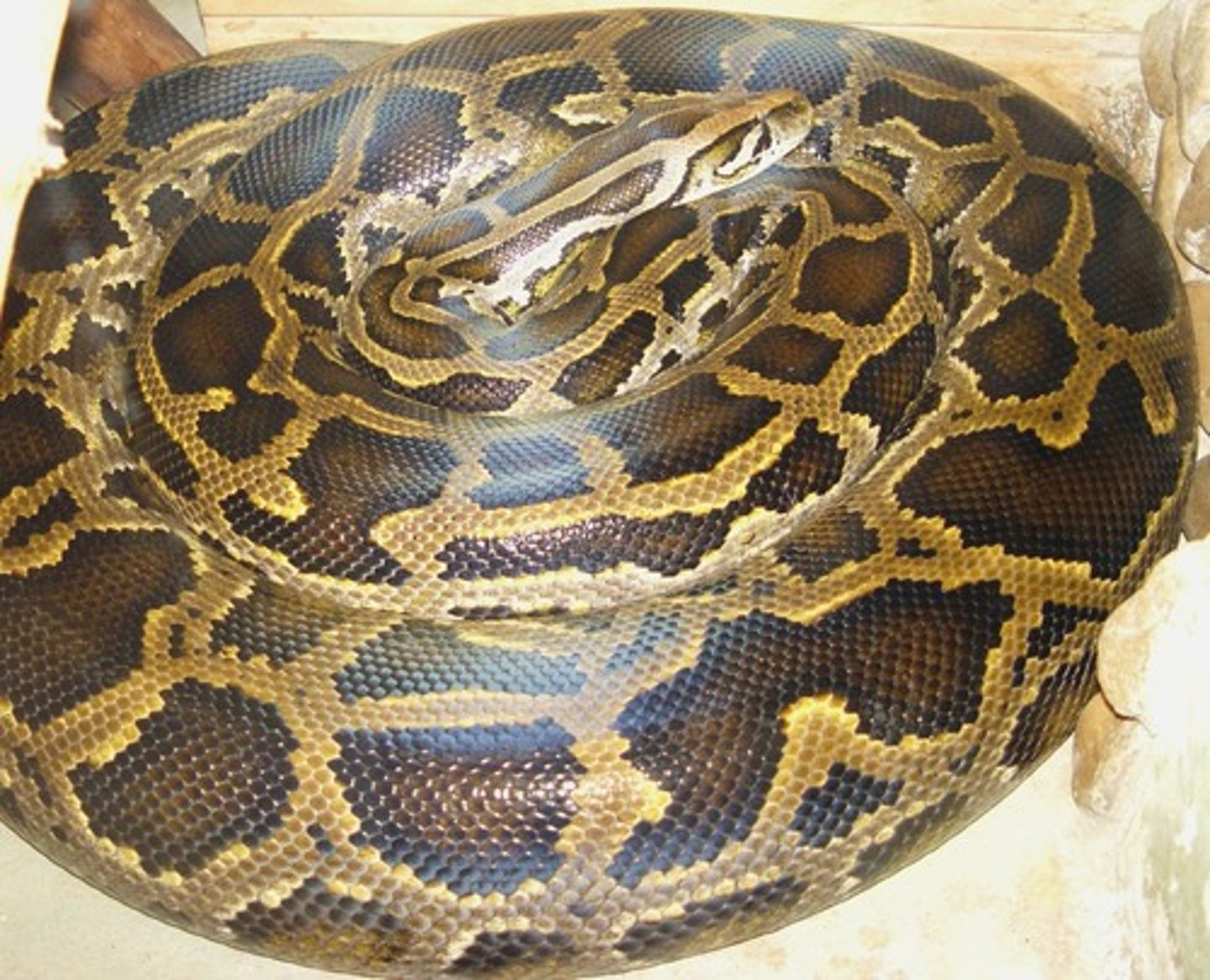
homeostasis
maintenance of a relatively constant internal environment in a varying external environment
--------------------
depends on negative feedback
- whenever conditions deviate from the normal state the set point, mechanisms engage to restore the system to that state
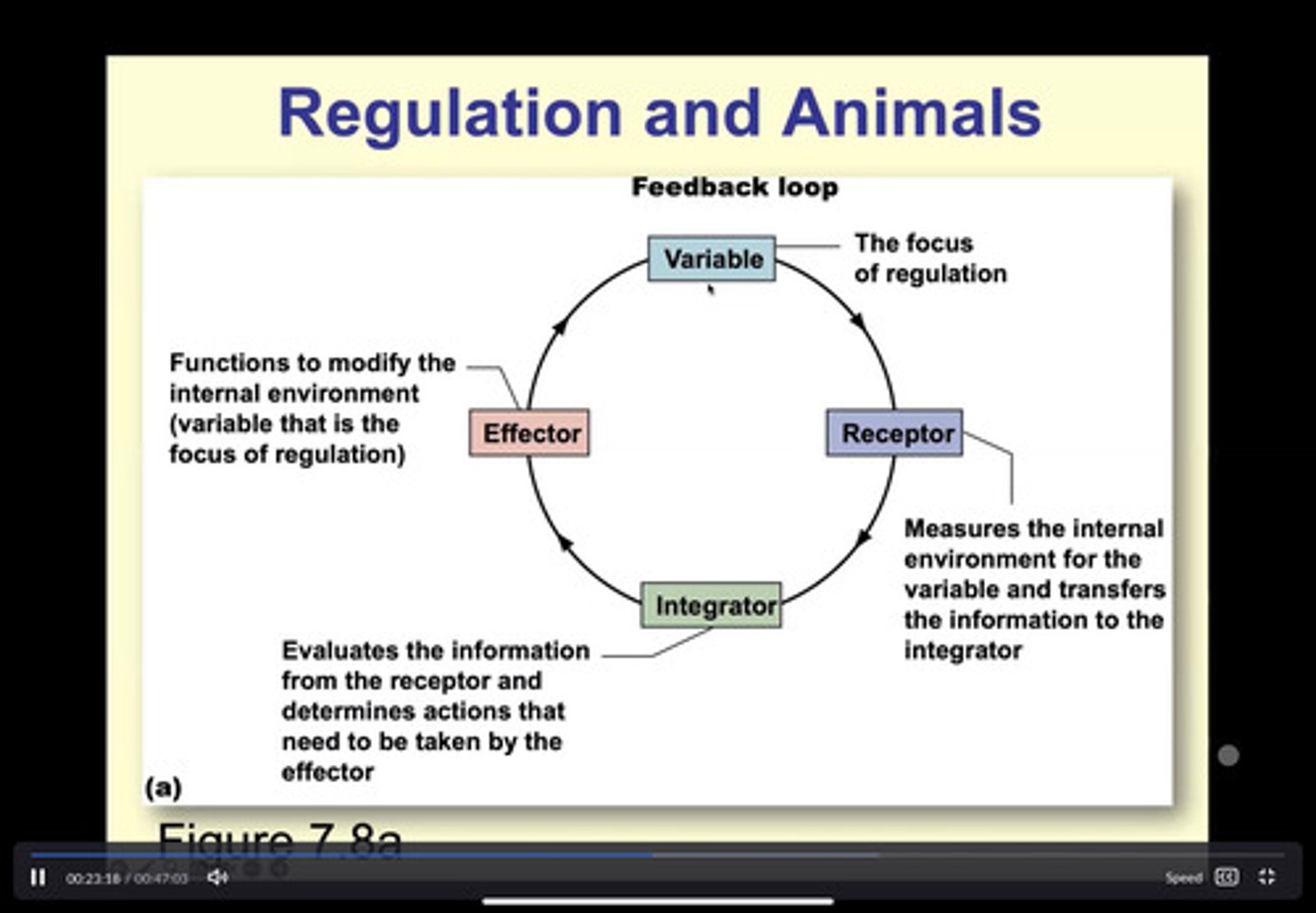
aerobic respiration
animals, like plants use this to convert the energy in organic compounds into energy that cells can use
oxygen regulator
most organisms are able to maintain normal oxygen consumption levels even when external oxygen levels drop below normal
very small animals vs larger animals
SMALL
- acquire oxygen by diffusion
--------------------
LARGE
- cannot rely solely on direct diffusion across the body surface
aquatic environment oxygen...
- may be limiting
- may be taken from the water or from the atmosphere
some animals are oxygen conformers
mainly sedentary marine invertebrates such as cnidarians and echinoderms
- minute animals, often part of the zooplankton, take up oxygen by diffusion
gills
vascular out-foldings of the body surface that are in direct contact with the water and exchange gases
- can be simple and distributed over the body, or complex and restricted to a specific region
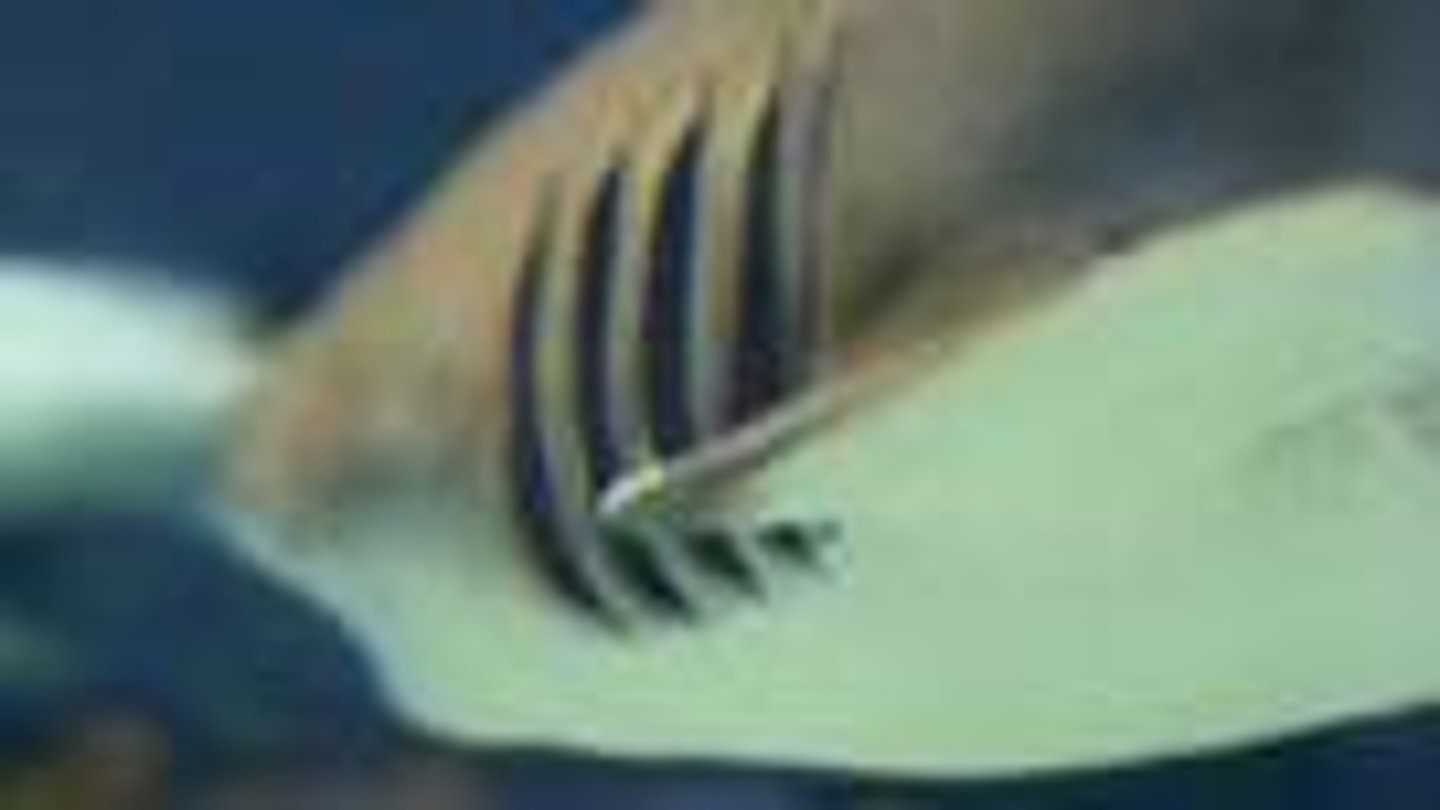
some aquatic animals must surface for oxygen
- aquatic insects have a tracheal system and surface to fill it with air
- aquatic turtles and mammals have lungs
water balance
the balance between the uptake and loss of water with the surrounding environment
terrestrial animals gain water
- directly through drinking and eating
- indirectly through cellular respiration and the production of metabolic water
--------------------
EX:
Frog
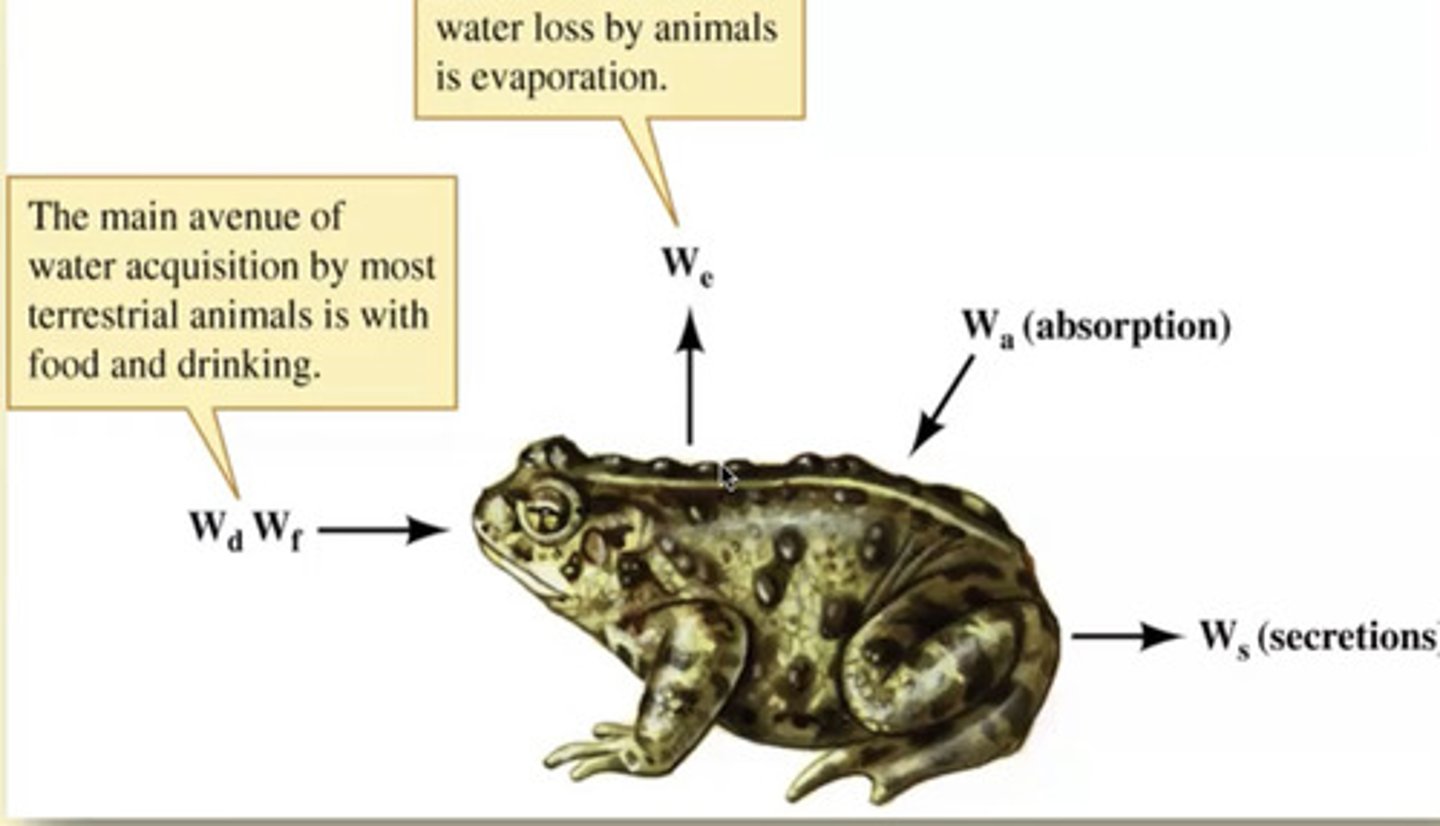
metabolic water
water generated during metabolism
terrestrial animals loos water
- urine and feces (mammalian kidneys can reduce water loss)
- evaporation from the skin
- exhaling moist air
water balance can be facilitated through
dramatic behavioral or physiological shifts
- some animals migrate, leaving areas during the dry season
- others undergo estivation or diapause
estivation
avoid effects of drought through a period of dormancy (physiological inactivity)
--------------------
EX:
- spadefoot toads in the desert (SW)
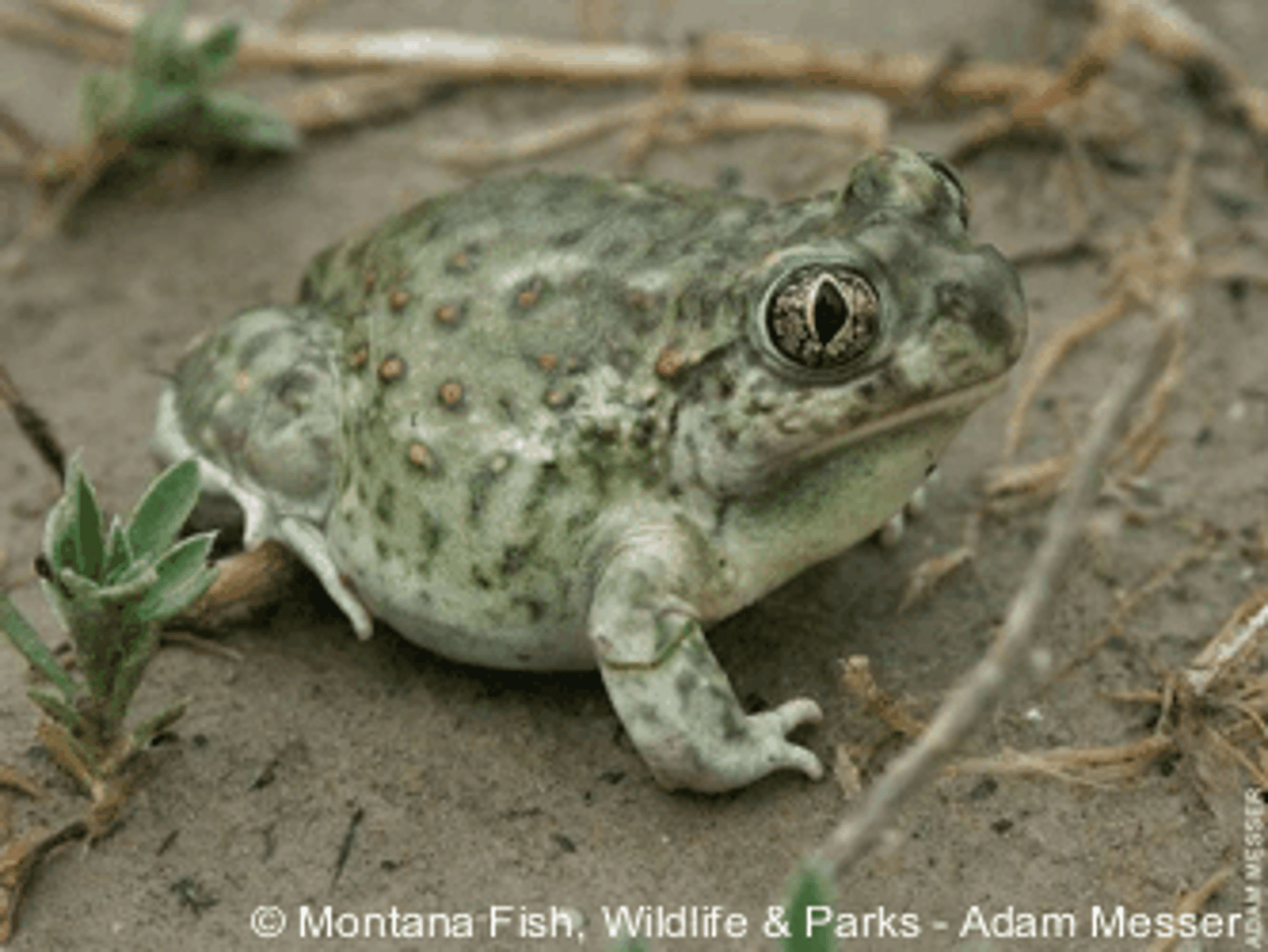
Diapause
entering a state where feeding, mobility, and reproduction stop
- emerge when conditions improve
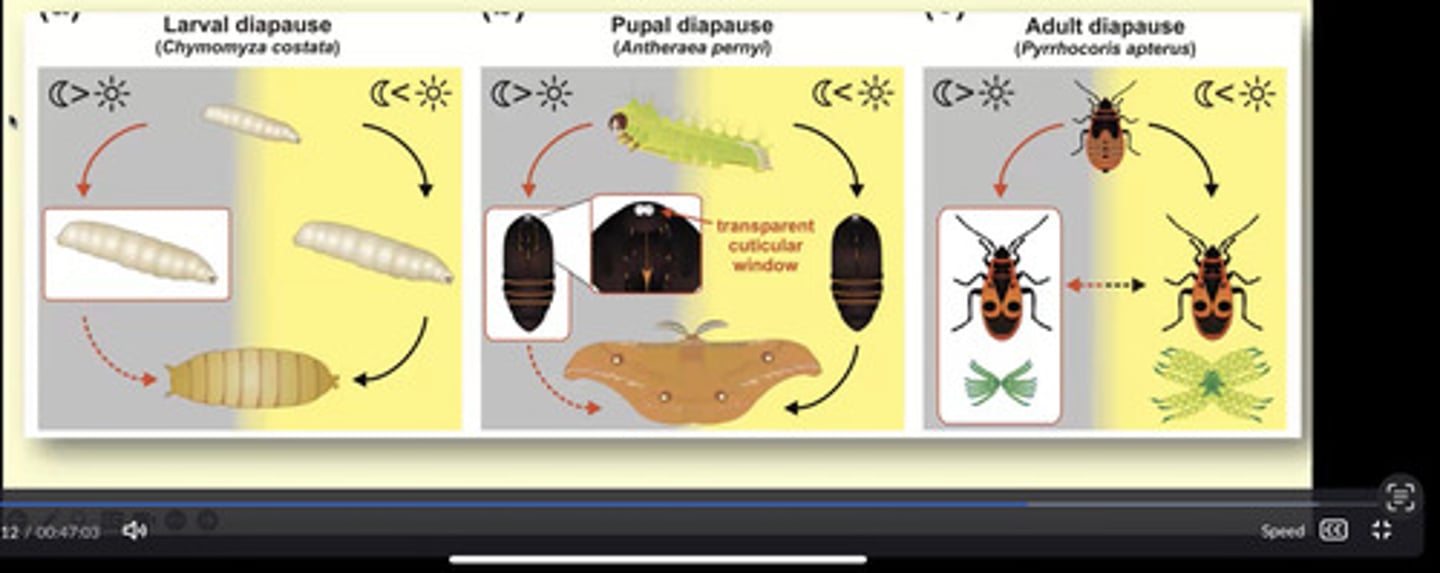
other animals are active during the dry season but reduce respiratory water loss
mammals lower the temp of the air they exhale
- nasal membranes are cooled causing moist air from the lungs to condense
desert mammals show adaptations to dry conditions
- small mammals active only at night (remain in a burrow during the day)
- some animals extract water from the food they eat (either directly or indirectly)
- some have very concentrated urine and dry feces
- some tolerate a level of dehydration (desert rabbits lose up to 50% of body weight due to water loss)
desert reptiles
have many adaptations to dry conditions
- may shift to being active only at night
- can store energy and water
Why aren't freshwater animals osmoconformers
- there hyperosmotic (have higher salt concentration in their bodies than the surrounding water
marine animals are...
hypoosmotic
- they have lower salt concentration in their bodies than the surrounding water
thermal conductivity
rate of heat exchange with the environment influenced by boundary layer
----------------------
EX:
- feathers
- hair
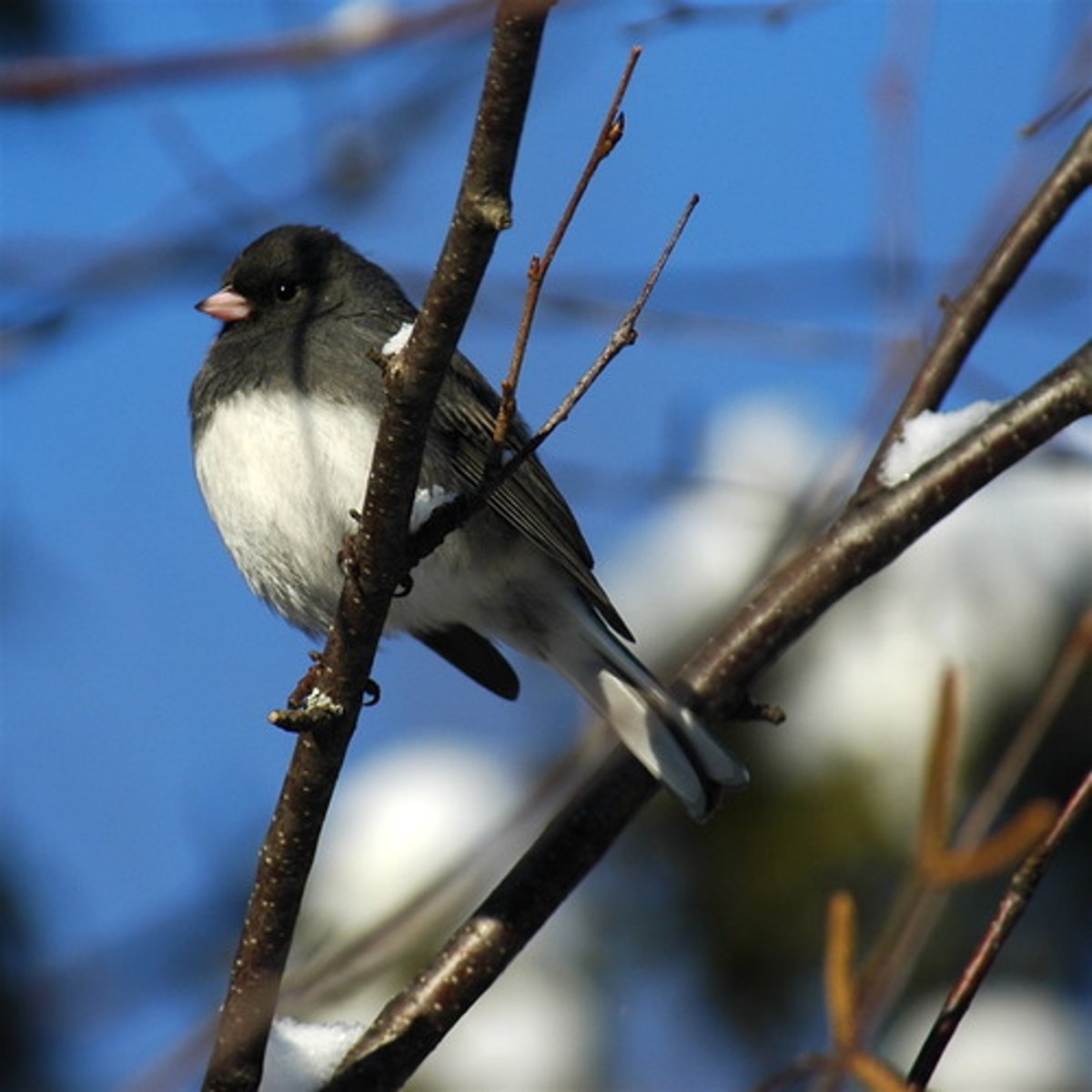
How does an animal contain core temperature?
animal balances both gains and loses of heat
- to the external environment through changes in metabolic rates
- changes in metabolic rate
Why is heat lost via metabolism
conversion of potential energy to kinetic energy from cellular respiration is not perfectly efficient
- most energy lost as heat
- 2nd law of thermodynamics
heat exchange
core changes heat with the surface through conduction and convection
- influenced by the thickness of L and blood flow
- surface exchange heat with the environment through conduction, convection, radiation, evaporation
terrestrial animals
have much larger changes to their thermal environment than aquatic animals
air has a lower specific heat and absorbs less solar radiation
- incoming solar radiation (day) can rapidly increase heat
- loss of radiant heat (night) can rapidly decrease heat
- aquatic animals have low tolerance to temperature change
poikilotherm
animals that have a variable body temperature
----------------------
Not synonymous with conformers and regulators
characteristics of poikilotherms
1. low metabolic rate
2. high thermal conductivity
3. aerobic respiration during normal activity
4. under increased activity and stress, most energy is produced anaerobically
-depletes stored energy
- lactic acid accumulates in muscles
Poikilotherms use mainly ______________________
behavioral thermoregulation
- seeking out appropriate microclimates
- environmental temp allow near-optimal body temps
- bask in the sun to warm
- rest in the shade to cool
change conduction between the animal and rocks/soil by...
- raising and lowering the body
- changing the body shape
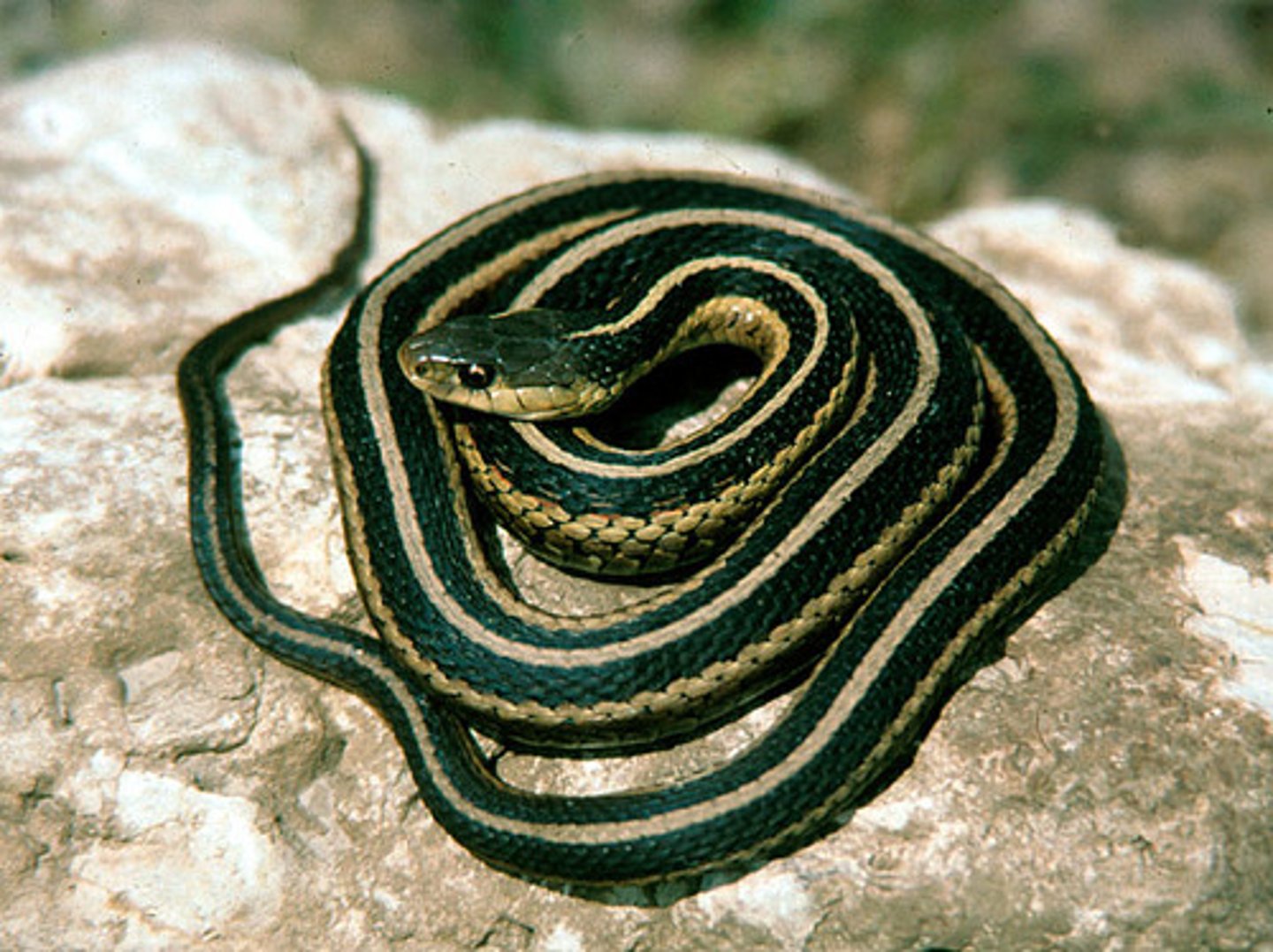
Homeotherm
animals that have a constant, or nearly constant, body temperature
----------------------
Not synonymous with conformers and regulators
Animals regulate body temperature through
- behavior
- physiology
- morphology
ectothermy
process of maintaining body temp through the exchange of thermal energy with the surrounding environment
- animals that do this are ectotherms (>99.9% of animals are ectothermic
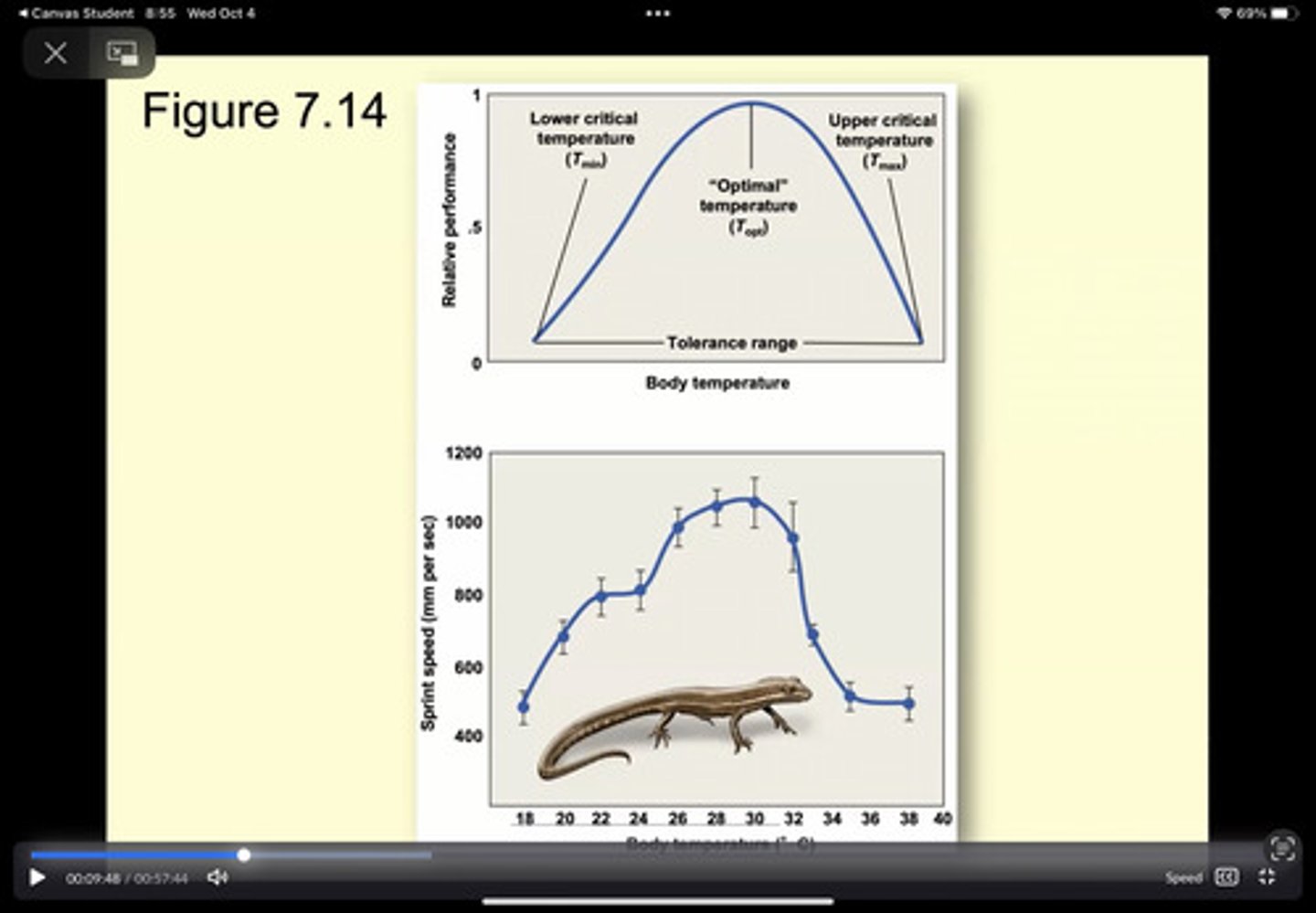
endothermy
process of maintaining body temperature through internally generated metabolic heat
- animals that do this are endotherms
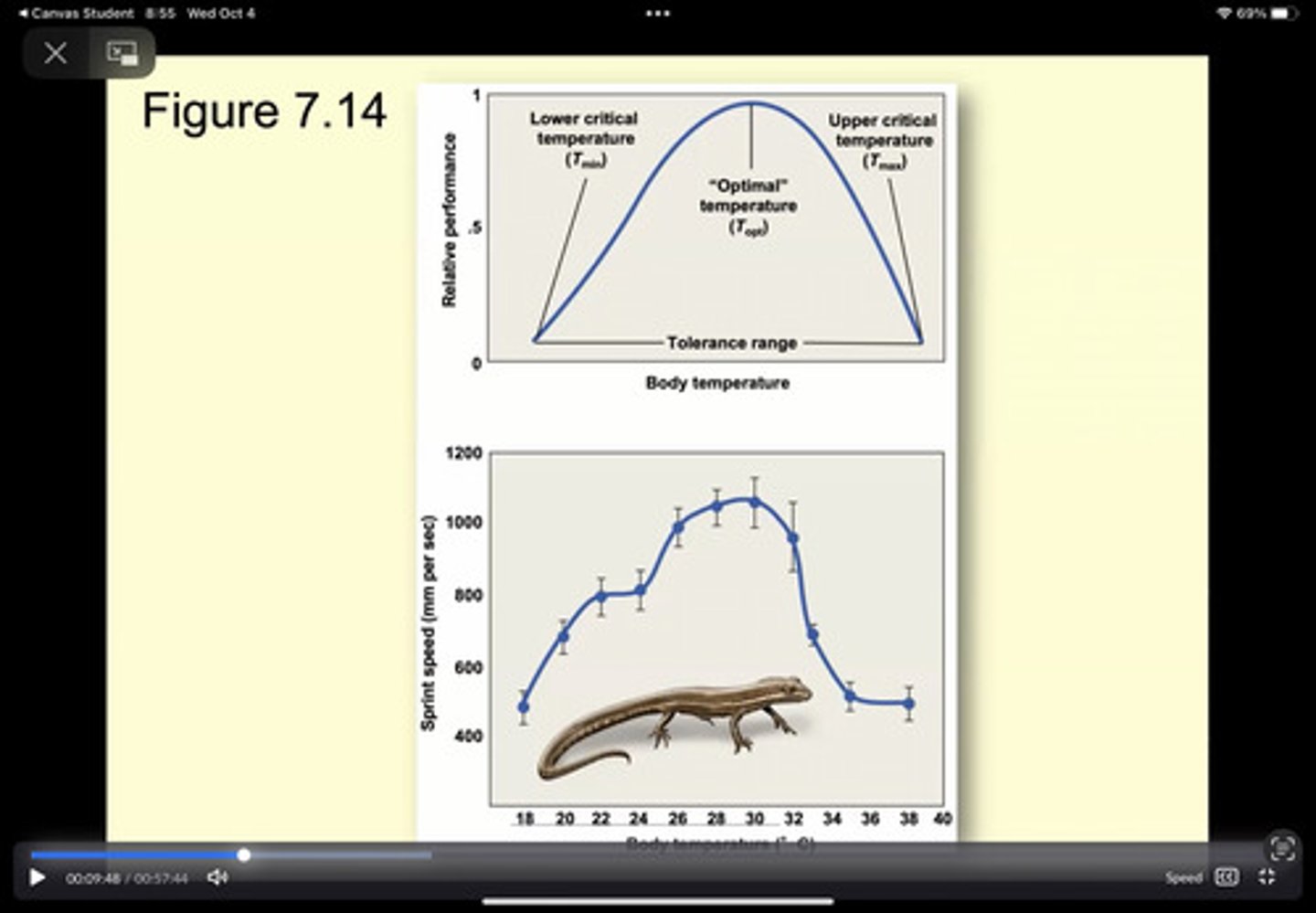
Blouin Demers and Weatherhead
studied behavioral thermoregulation in black rat snakes
- determined that the physical models that maced snake reflectance and conductance
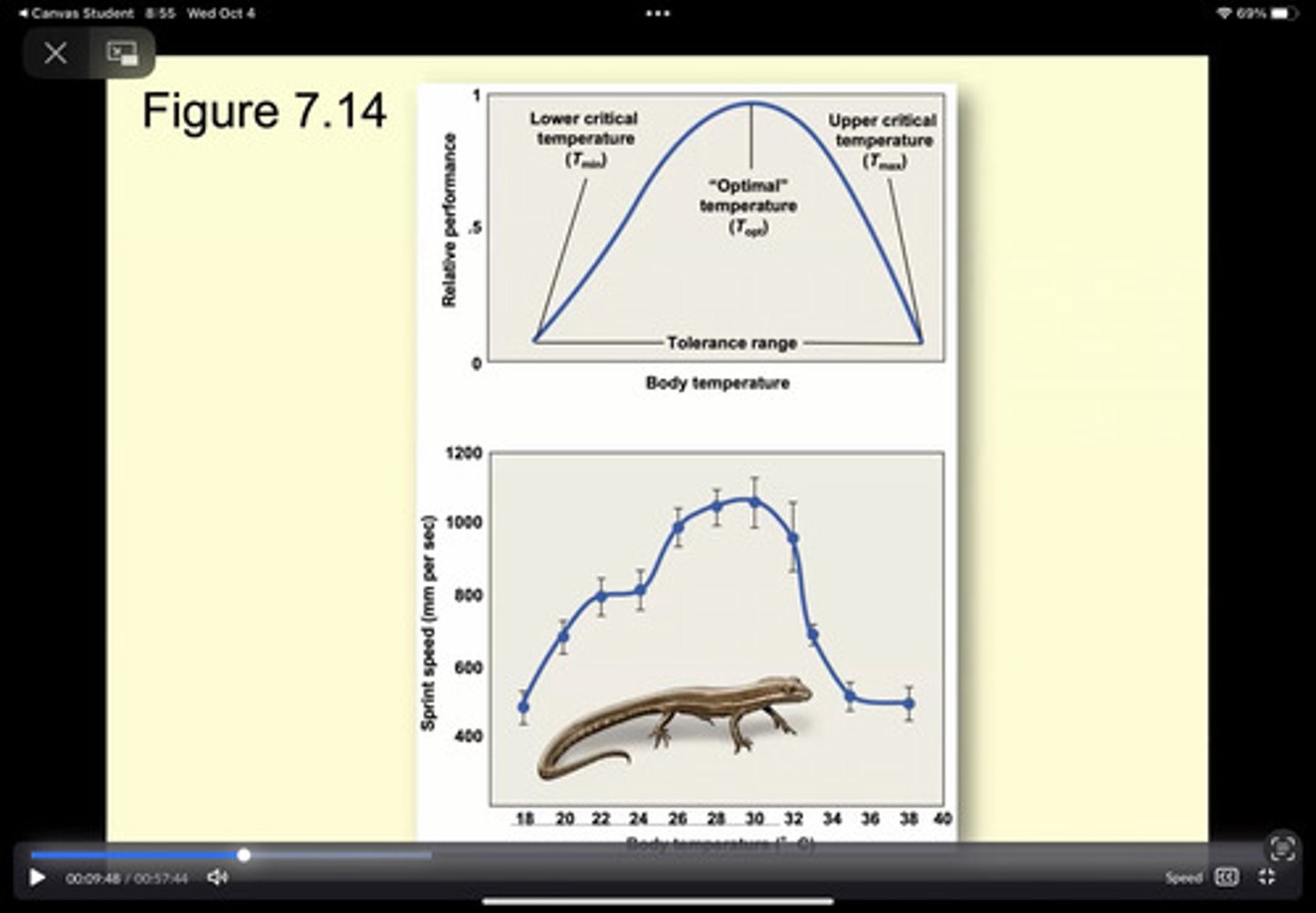
what other important traits can tradeoff with behavioral thermoregulation
- predation risk
- energy balance
- reproduction
temperature accumulation (poikilotherms)
allows a shift in the relationship between body temp and performance
- usually involves biochemical changes, such as shifts in enzyme systems
thermal conductivity of water
is about 25X greater than that of air
- animals in aquatic environments reach a temperature equilibrium with the water much faster than terrestrial organisms do with air
- it is much more difficult for aquatic organisms to have a body temp much different than the water temp
aquatic poikilotherms
are poorly insulated
- heat produced in muscles => blood => gills/skin => transferred into the water by convection
----------------------
some sharks and tunas use a counter-current exchange system to retain some body heat
seasonal water temperatures are relatively stable
- acclimate to changes from one season to the next
- slowly changing T-max and T-min as the water temperature slowly changes; fish are sensitive to rapid changes
Birds and mammals produce heat through
aerobic cellular respiration
- not 100% efficient
- energy is lost as heat
what is different about the liver cells in mouse vs those in lizards
- more mitochondria
- "leaker" inner mitochondrial membranes
Basal Methabolic Rate
measured by the rate of oxygen consumption
- rate of respiration = body mass - grams body mass^75
- exponent varies across taxonomic groups
(range is 0.6-0.9)
(if exponent is 1 , a doubling in body mass would equate to a doubling in metabolic rate)
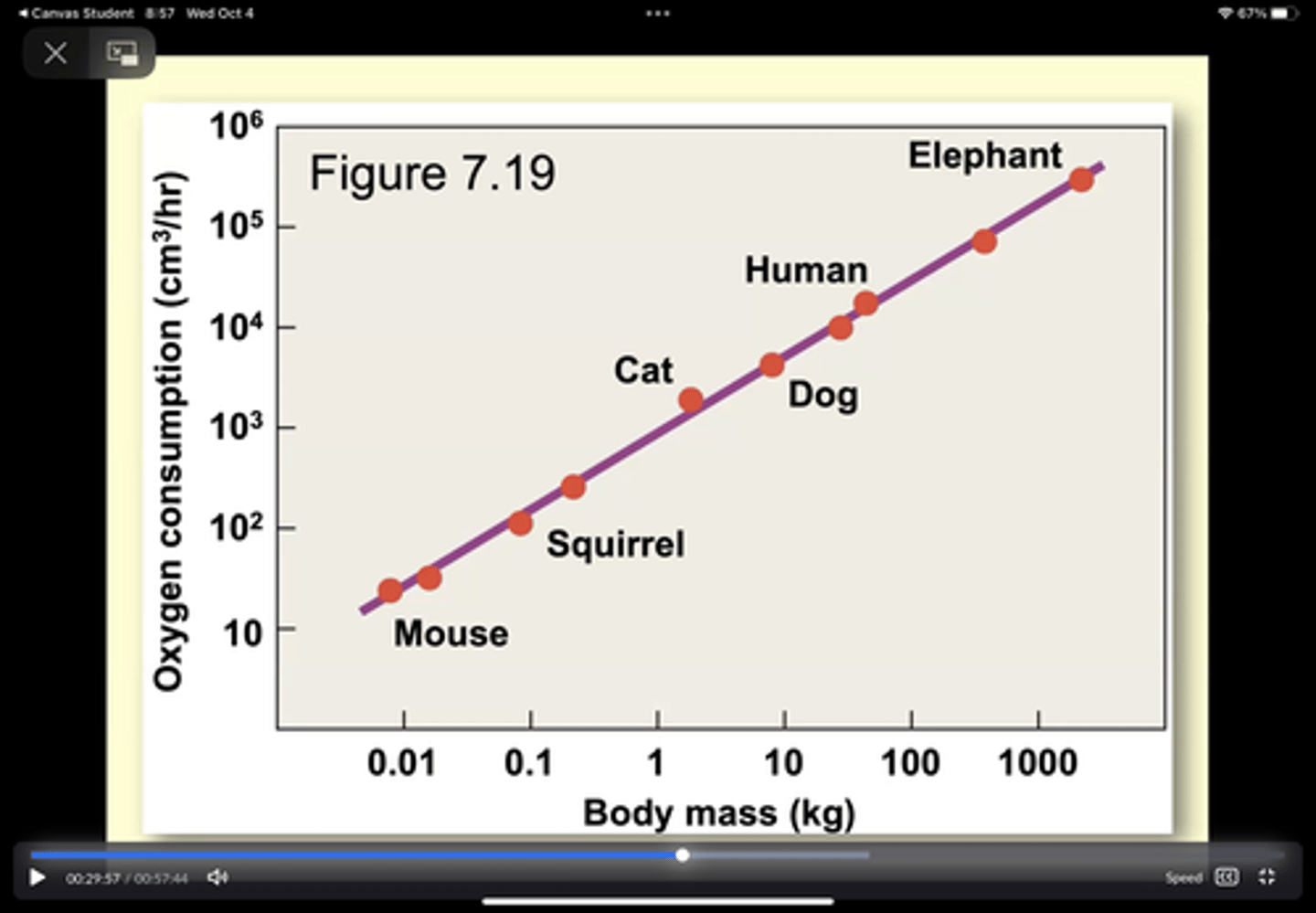
thermoneutral zone
range of environmental temperatures within which the metabolic rates are minimal
- outside of this zone, past the critical high and low temps, metabolic rate increases
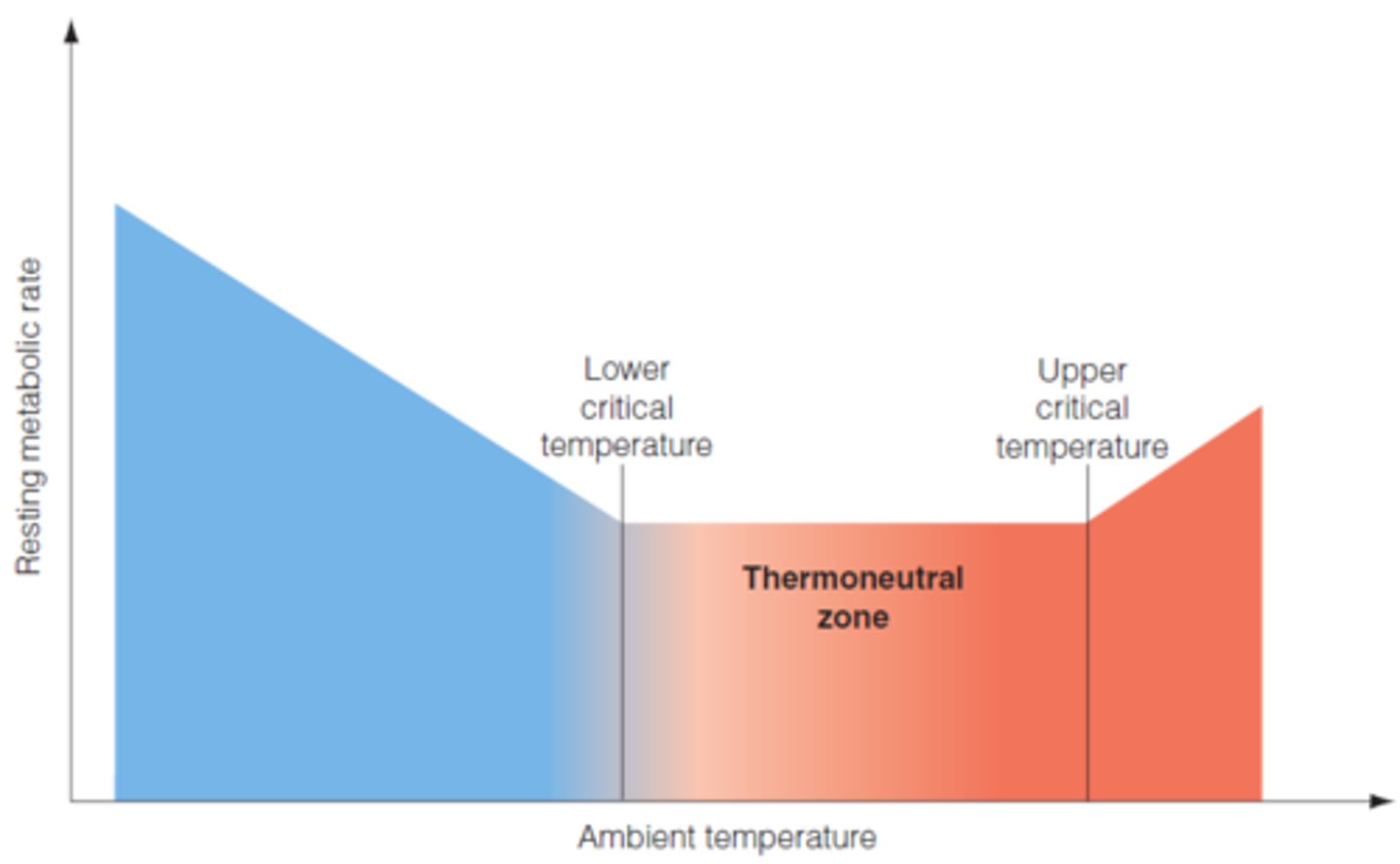
The fur of mammals
insulation value varies with thickness
- fur thickness can change with season (accumulation)
aquatic mammals have no hair
instead they have a layer of fat beneath the skin
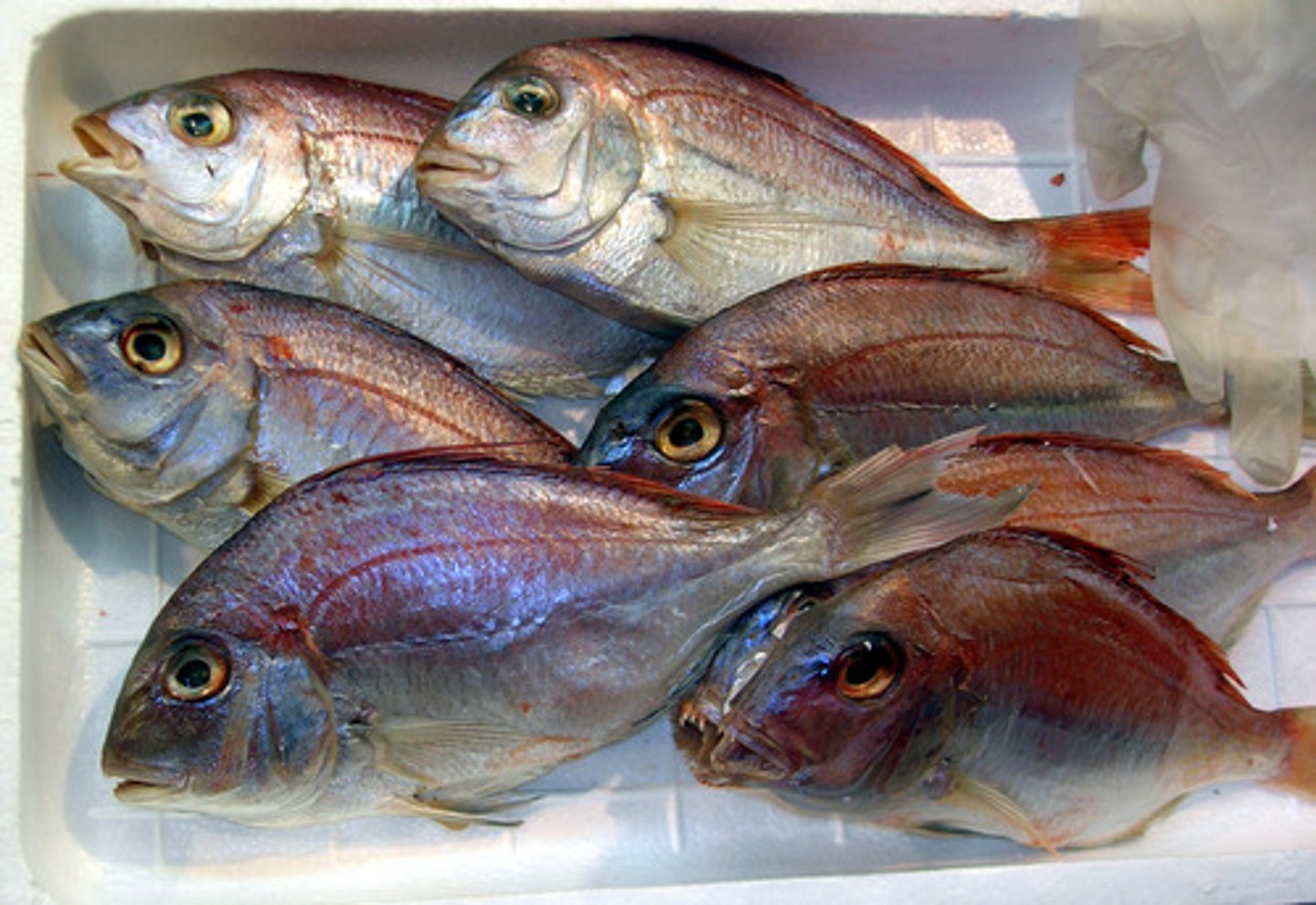
feathers of birds
heat loss is reduced when the feathers are fluffed
arctic and antarctic birds
have a layer of fat beneath the skin
Insulation
keeps heat out of the body
Animals from hot environments must
- rid themselves of excess body heat
- prevent heat from being absorbed to begin with.
----------------------
some insects have a fur-like coat on the thoracic region (used to retains high temperature for flight muscles
Homotherms (endotherms)
raise body temperature by
- shivering
- brown fat
----------------------
lower body temperature by
- evaporative cooling
shivering (raise body temp)
involuntary muscle action that increases heat production
brown fat (raise body temp)
some small mammals burn brown fat
- has more mitochondria and generates more heat
- found in hibernators and babies
evaporative cooling (lower body temp)
moisture evaporated from the skin and heat is lost
- panting and sweating
- gular fluttering
- wallow in water or wet mud
Ectothermy benefits
- lower metabolic rate requires fewer calories per gram of body weight (less food)
- can allocate more energy to producing biomass than to metabolism
- can reduce or curtail metabolic activity when food or water is limited, or environmental conditions are extreme
- can live in environments where food and water are limited
Ectothermy costs
- temperature of the environment determines activity
- maximum body size is constrained because heat is absorbed across the body surface
- surface/volume ratio becomes to low for heat to warm the entire body mass
- larger ectotherms can live in only in warmer environments
Endothermy benefits
- homeotherms can remain active even if environmental temperature varies
- maximum body size is not constrained because heat is generated internally
- large endotherms can live in cool environments
Endothermy costs
- higher metabolic rate requires more calories per gram of body weight (more food)
- small endotherms must eat almost constantly
- usually allocate more energy to metabolism than to producing biomass
- producing insulation
altrical state (endotherms)
blind, naked, helpless, ectotherms
- depend on parents to maintain body temperature
- allow them to allocate more energy to growth early in life
linked to the selection for high levels of activity sustained by aerobic metabolism
- improved foraging, defencse, home range size
- if maximal MR goes up, so does resting MR
linked to parental care
- embryos particularly sensitive to temp
- early endothermy regulated to parental period only (expanded to non parental periods over time)
Heterotherms
have characteristics of both ectotherms and endotherms
- maybe daily or seasonally or only in certain situations
insects are generally
ectothermic poikilotherms
- adults of most flying species are heterotherms
- have a high metabolic rate when flying
- insects flight muscles function between 30-44°C
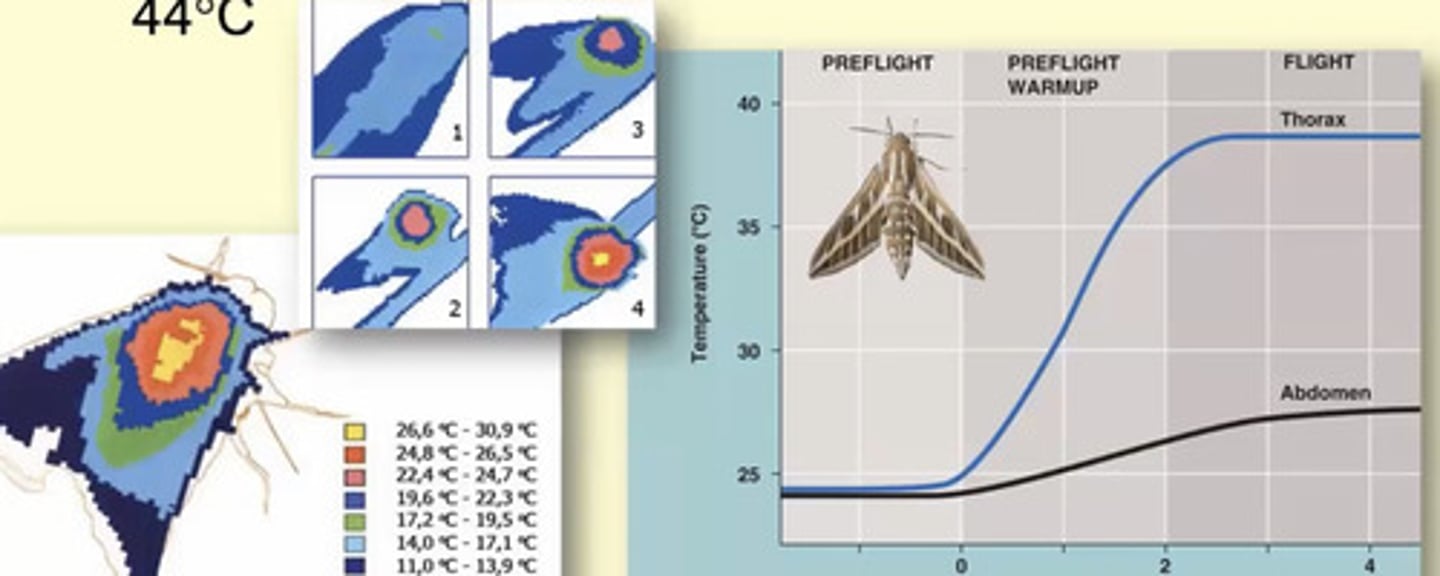
torpor
metabolic inactivity => a drop in body temp to ambient temp for part of a day
----------------------
- diurnal animals = humming birds (night)
- nocturnal animals = bats (day
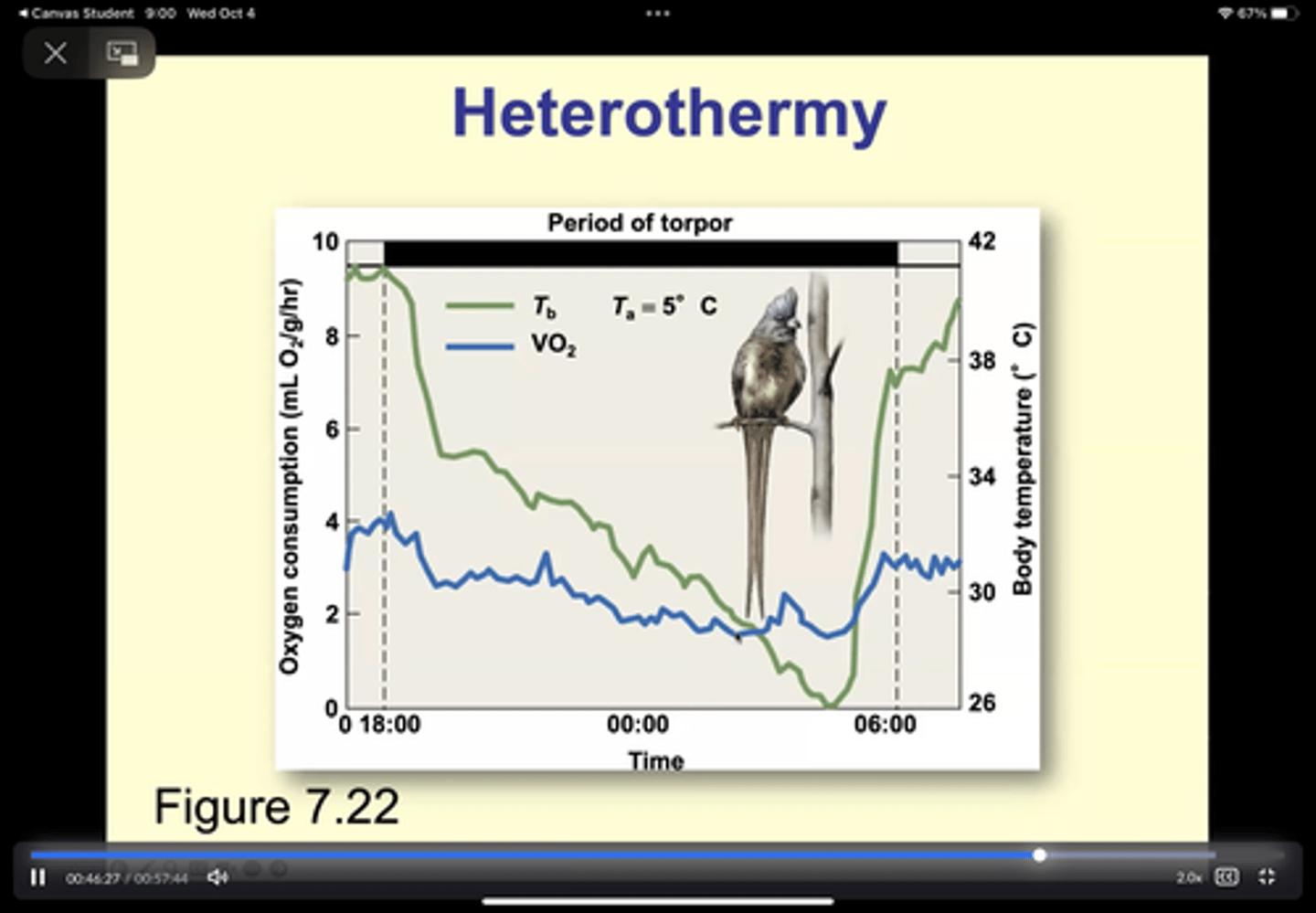
hibernation
the dropping of the body temp to near ambient temp for a long period of time during the winter
